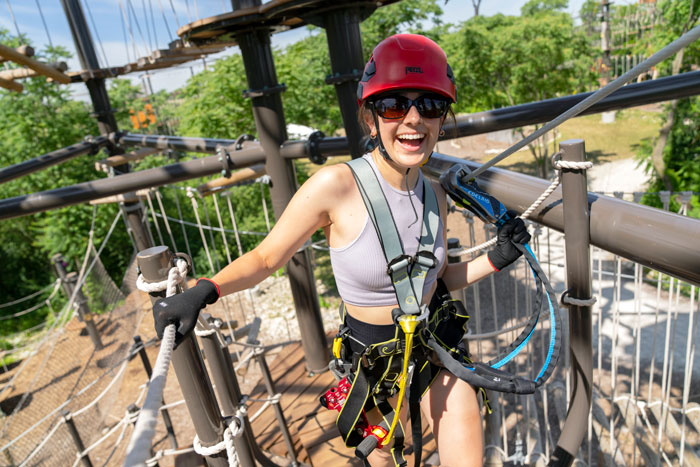There are some who prefer to utilize their leisure time with a little meditative quiet, to decompress and reset by reading a book on a park bench or strolling along a nature trail. And then there are those who prefer to decompress and reset by blowing off steam with a strenuous climb on a climbing wall, an adrenaline-filled free-fall or zip-line ride, a challenging traverse of a high ropes course or a competition with friends on a ninja-style obstacle course. And fortunately for those in the latter camp, there are more options than ever for quenching that thirst for adventure, both indoors and outdoors.
Andrew Miller is vice president of a company assisting all types of challenge course, zip line and aerial park operators with design, installation, operations consulting, inspections and training. This includes camps, schools, municipal and military entities and commercial aerial park operators. “The majority of projects end up falling within the semi-custom category—essentially modifying predesigned courses to meet a customer’s needs, audience and/or site.
“The industry is coming out of a decade of rapid growth,” explained Miller. “That growth has leveled off, and the industry
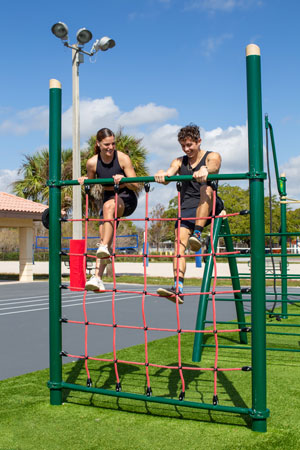
is less focused on innovation and more on product refinement, standards, risk, etc.” And as the industry has quickly grown, standards, regulations, practices and equipment have evolved. Things that were the norm even a few years ago—design and operation practices—have been updated with better strategies and equipment.
One way to keep up with evolving practices is through the international trade organization Association for Challenge Course Technology (ACCT), which advocates for the challenge course and adventure industry. ACCT develops, refines and publishes standards for installing, maintaining and managing challenge courses, as well as providing forums for education and professional development.
According to Miller, managing challenge courses and adventure attractions is all about managing risk. His company offers operator training, and he explained that combining outside training with a robust in-house program helps to minimize the potential for significant staff errors, to which many incidents are attributable. “Operators who only train in-house often suffer from operations creep. This is when small operational shortcuts become engrained as regular practice over time. As these habits are passed along, daily habits can veer from written policies and procedures, and risk management gaps can result.”
Miller said they offer a wide range of training following the ACCT curriculum and standards, delivering training at the client’s site, specific to their facility, equipment, etc. “Operators can choose to add a testing day to the training so their staff can be certified. We also offer open-enrollment trainings in the spring and early winter at our facilities in… North Carolina.”
Ian Gammie is content manager for a Louisville, Colo.-based company that engineers and manufactures products for the adventure industry, and braking technology is one big focus. “All of our climb, zip and jump devices come equipped with our patented magnetic braking systems, though each device is also fine-tuned for the demands of its specific activity.”
He said that from a user perspective, magnetic braking feels extremely smooth and consistent, “which is reassuring when you’re lowering from the top of a tower or a climbing wall.”
The systems are also naturally self-regulating. “Regardless of someone’s size, the experience is the same; parents are lowered at the same rate as their kids, for example.”
From an operator perspective, Gammie said that with magnetic braking there aren’t any parts rubbing together. He
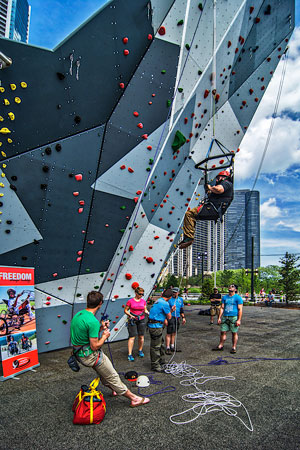
detailed how the systems utilize an eddy current instead of relying on friction. “Since there’s no internal contact, less wear is put on the internal components. What you end up with are extremely reliable devices that have remarkably long lifespans, even after heavy use.”
Technology has also evolved with regard to automated video systems, as facility visitors often want a record of themselves zipping through trees or free-falling from a tower. Gammie’s company has partnered with a video team to develop a user-friendly system allowing guests to record their experiences and watch the footage immediately. “Visitors don’t have to pay for the video ahead of time; after the ride, they scan a personalized QR code which takes them to a video preview page of their experience. From there, they have the option to buy the full video. The whole transaction is done via smartphone”
Outside of Chicago, The Forge: Lemont Quarries in Lemont, Ill., is a state-of-the-art outdoor adventure park featuring a wide-ranging mix of recreational activities set among a reclaimed natural landscape. Offerings include archery, laser tag, axe throwing, paddle sports, scavenger hunts, gemstone panning, and running and mountain biking trails. But for those seeking real exhilaration, it’s also home to one of the largest challenge courses in North America, with ropes courses, a rock climbing wall, rappelling and zip-lining.
“Our zip line is over 1,200 feet long and gives you amazing views as you glide over the Forge Quarry,” said General Manager Brad Donati, who added that their challenge course has more than 200 unique rope course elements. “Our elements are designed to offer easy, intermediate and advanced elements to make sure there is an adventure for everyone. We even have one tower that is designated as (featuring) our most challenging elements.”
Zip-line options for operators include canopy tours, allowing for flying through tree canopies on a series of interconnected lines built in the upper portion of a forest. Integrated systems can be designed that are efficient to operate and require little ongoing maintenance. Zip tours utilize pole-based platforms and towers that can be installed in a wide variety of sites and landscapes. High-speed long lines—two, four, six or more parallel lines—offer big thrills and high throughput.
Donati said that rappelling is a fun option at The Forge. “You can do it from 120 feet in the air! Climbing our tallest tower, once you reach the top you have the option to rappel all the way to the bottom. We also have other free-fall opportunities throughout the course, which are the most fun ways to get off each tower.”
Donati also described their 90-foot rock climbing wall as a unique outdoor climbing experience. “We use auto belays on
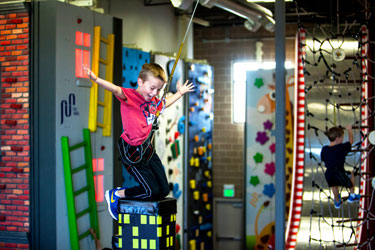
our wall to make sure that guests of all experience levels get an opportunity to try to climb. We change the routes periodically throughout the year, providing different challenges each summer to guests.”
As part of each ticket purchase at The Forge, guests must go through a gear-up and orientation process, according to Donati. “During this process, guests are instructed by a guide on how to use the equipment. At our practice lines, guests will be able to test out their new-learned skills to make sure they can practice on the ground before going in the air. This is required by all guests, and an employee will test you out before entering the course.”
Donati said they worked hand-in-hand with their manufacturer to design a course that is unlike any others. “Our design is one-of-a-kind and is ‘choose your own adventure,’ allowing guests to choose which adventures they’d like to take on and in whichever order they’d prefer.”
But The Forge is also dedicated to education, conservation and restoration. Programs include summer camps, customizable team-building activities and specialized service opportunities for groups and individuals. “We can accommodate groups of 10 to 500-plus guests,” said Donati, ranging from corporate groups to scout troops to birthday parties.
Safety is a top priority at the park, according to Donati, with the towers being inspected daily prior to use. “All guides on the course are thoroughly trained, spending 40-plus hours in training before they take an exam to be certified by our leadership team. As we follow standards set forth from ACCT, our course goes through a third-party inspection each season to ensure everything exceeds the standards of operating.”
“Annual qualified third-party inspections for challenge courses, zip lines and aerial parks are mandated through ACCT standards, required by insurers and mandated in some states and municipalities,” said Miller. More than checking a box, he said an annual inspection report is a roadmap regarding the health of a facility and objective hazards or risks that could result in an incident if not properly mitigated. He explained that their inspectors do thorough hands-on inspections of critical components of a given facility. A partial list of things examined includes “primary structural components, including trees, poles and guy lines; life-critical components like belay cables and zip lines; and program and staff
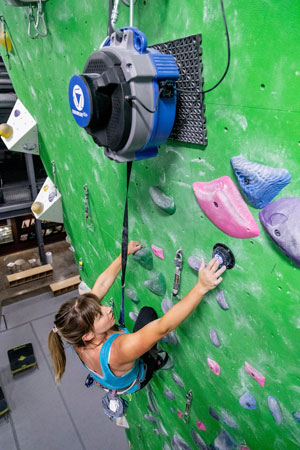
equipment.”
Gammie stressed that safety is their top priority, and they also take inspections and maintenance extremely seriously. “The requirements vary slightly between devices, but there are required daily, weekly and biannual inspection procedures that all facilities using our devices must follow. (Our) devices are also required to undergo annual service appointments with certified service technicians.”
Climbing continues to be a popular adventure activity, and not just at climbing gyms. Parks and rec facilities, colleges and universities, schools K-12, entertainment centers, YMCAs and resorts are examples of venues more commonly offering climbing walls and programs.
Bryce Benge is president of an international company providing climbing walls and products to the climbing industry. They also offer maintenance and inspection services, with their inspectors adhering to Climbing Wall Association (CWA) recommendations. And they’re involved with staff training, route setting and design consultations. “Climbing wall design is not to be overlooked as it’s an integral part of the success of the climbing gym,” said Benge. “While climbing is the product, walls, holds and route setting are components of the product.”
Benge said it’s important to start early and develop a list of goals for your climbing space and walls. “Integrate your building or climbing space into and around your wall design. Thoughtful layout of your walls, programming uses and user types will help ensure your climbing wall is a success.”
He explained that space and the separation of spaces is a leading consideration in the layout of a facility, as most facilities strive to support different user groups and programs, such as children’s zones and instructional areas.
Incorporating various wall profiles—slab, vertical, overhang—keeps walls creative and diversified for all skill levels.
Also, climbing-specific training areas are an additional amenity used to increase the breadth of users, according to Benge. “Walls designed for training purposes can offer experienced climbers more options for challenge and progression than typical climbing walls alone.” He said these are often tucked in a corner, “allowing users’ space for uninterrupted and consistent climbing workout routines.” Many operators also design spaces with events and competitions in mind.
Adaptive climbing and inclusivity are also considerations. “Accessible climbing walls and climbing areas are growing and changing segments of the industry,” said Benge. “Most newly built facilities include accessible programming options and intentional adjustments in design to make climbing accessible to everyone. The most common approach is thoughtful wall angles in strategic locations and adaptive rope anchors to better accommodate certain athletes’ needs.”
As far as outdoor applications, Benge said they’ve designed, built and installed climbing boulders for many outdoor
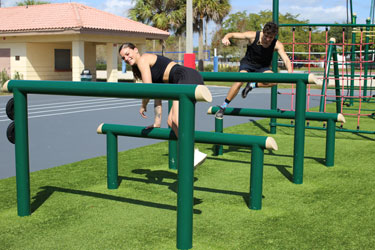
spaces, offering precast and custom-built boulders and towers that include natural routes and set routes with handholds, varying in difficulty. “Over the past few years, we’ve seen a lot of interest coming from parks and rec departments and their communities, looking for ways to retain, inspire and increase the number of users they serve.”
More climbing facilities have been adding auto belays to their walls, which are mechanical devices used for belaying on climbing walls, enabling a climber to ascend routes on a top rope without the need for a human belaying partner. Gammie’s firm offers an auto belay used by many in the industry, and last year they introduced an enhanced version that “actually catches climbers when they fall, rather than immediately lowering them back to the ground,” according to Gammie. “It gives them multiple opportunities to work on difficult moves and challenge themselves on routes that may have been just beyond their ability level before.”
Gammie said one benefit of auto belays is that more climbers can get on a wall than with top roping or lead climbing. “Especially in a school setting, where there are massive influxes of students coming into the gym at the same time, you really see how (these) can maximize efficiency and get more people climbing on more routes than traditional belaying.”
Benge said auto belays have pros and cons, and pointed out that they’ve seen improvements over the years. “Some newer auto belay systems may incorporate features such as redundant safety mechanisms, improved braking systems, and easier installation and maintenance procedures.”
He added that climbing facilities should have an operation and safety plan covering all types of climbing—top rope, lead, auto belay, etc. “Everyone should still learn the good old-fashioned style for belaying, allowing you to experience climbing with others.”
Outdoor ninja-style courses are also seen at a lot of adventure destinations. There are many options for predesigned courses which can be customized with 20 or more features to fit a variety of footprints and shapes, including straight line, closed circuit, S-shape, etc. Courses can be geared to all ages and abilities, whether for improving fitness, training & competing or just having fun.
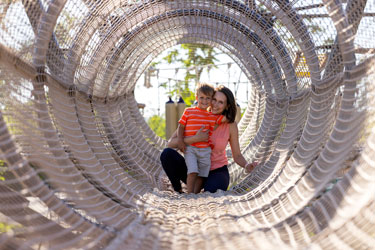
“Ninja courses are fantastic ways of capitalizing on the trend brought about in large part by the popular TV show,” said Allison Abel, director of marketing for a California-based provider of ninja courses and outdoor fitness equipment. “I think, if we have a pop culture phenomenon that encourages kids and young adults to push their physical boundaries to make themselves fit, let’s embrace it as much as we can—and if we can encourage them to do so in parks and other public spaces, so much the better.
“Ninja courses are fantastic as part of an overall adventure park type of facility, allowing people to really push their athleticism as far as it can go! Besides ninja courses, there are also more traditional obstacle courses available, with features like rope climb walls, over-under bars, vertical and horizontal ladders, and jump steps.”
Ninja courses are especially helpful at reaching the elusive tween and teen audiences. “Kids enjoy playgrounds, but generally can master all the elements in a typical park well before they reach their teens,” Abel said. “Ninja courses give them something that has a strong play element yet at the same time provides endless challenge. Plus, you can complete the challenges any number of different ways. Some of the features in [our ninja courses] can be completed by virtually anyone; others will put even the most athletic individual to the test. In the end, it’s all about having fun while making yourself stronger and healthier!”
Many of the adventure attractions found outdoors can also be found at indoor adventure parks, family entertainment centers, community rec centers and other indoor destinations. In Naperville, Ill., the indoor adventure center Funtopia offers many attractions designed to provide thrills for all ages. There’s a ropes course, trapeze feature and jumping attraction, all requiring harnesses. The Giant Slide offers a free fall experience; a winch pulls you up, you decide how high and then let go.
The ninja-style obstacle courses are made up of different sections, and obstacles can be added, removed, rearranged
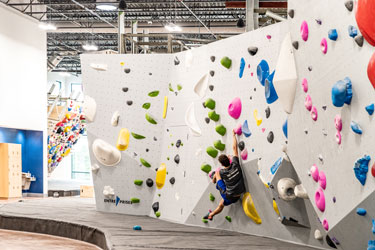
and modified, satisfying a variety of users.
Yasen Nikolov is an operating partner at Funtopia, and he said that while these courses do cater to those seeking more extreme training, “We’ve changed ours and made it a bit more kid-friendly; we have an inflatable bag instead of carpet or vinyl flooring; the obstacles are not as hard.”
There are also more than 50 interactive climbing walls. “The Fun Walls are divided into four zones,” said Nikolov, “the easiest, intermediate, harder and professional walls. The only routes we change are on the green professional wall.”
In fact, when it comes to choosing attractions and configurations, he said “We believe in movement and being active, and that’s what we try to preach through each and every activity.”
Funtopia also has food and beverage offerings and rooms for parties and events, which Nikolov said are good revenue generators. And they’re offering camps, a Climbing Academy and Empower Academy, which Nikolov said are for kids. “These programs are still new, and we can see their potential.”
As far as safety, Nikolov said “We have daily inspections of all safety equipment, weekly inspections of the whole facility and an annual inspection from the manufacturer. We’re trying to make most of the attractions intuitive and trying to put emphasis on safety. That’s the main focus of our staff; we always have staff onsite to help the customers.” RM



